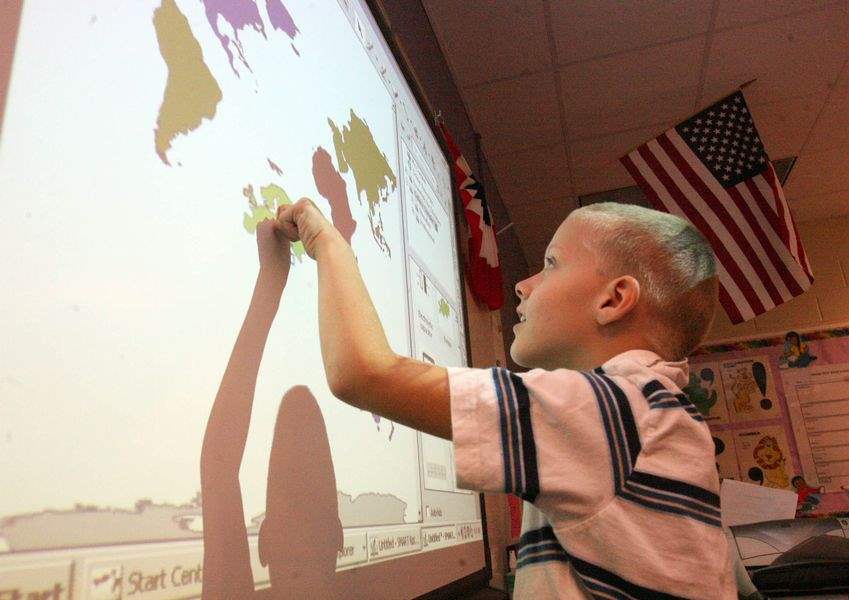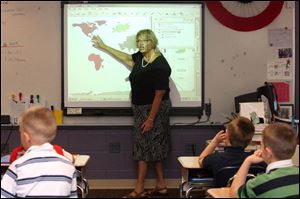
Hands-on learning moves to new levels
11/2/2008
Third grader Philip Zaborski uses the Smart board at Ottawa River Elementary School.
The Blade/Amy E. Voigt
Buy This Image

Third grader Philip Zaborski uses the Smart board at Ottawa River Elementary School.
When Jeanne Hufford gave her third-grade class at Ottawa River Elementary the option to practice vocabulary words out of the book - or go online using an interactive screen at the front of the room - their response was electrifying.
The class of more than 20 students emphatically opted for technology - over the textbook.
When asked why they choose the latter:
"Because it keeps our attention," one student said.
"It helps us learn better," another added.
"It's fun. I get to learn and it's fun at the same time," added Mark Huss, 8.
Mrs. Hufford, who five years ago was one of the first teachers in Toledo Public Schools to start using such classroom technology, explains the students' reaction simply.
"If they touch, they learn," she said.

Jeanne Hufford says she uses the interactive board in her classroom four out of six hours each day as a way to balance educational standards and keep the attention of her third graders.
Using technology such as an interactive white board, often referred to as Smart boards - a screen that combines the features of a projector, white board, and computer monitor - is just one of the many technological advances schools are using to educate children.
"It's hands-on and engages them," said Lisa Morse, a school improvement consultant with the Lucas County Educational Service Center. "For those students that learn by doing, it's much easier for them with that engagement."
From students with high achievement levels to those with special needs, each is able to go to the board and interact with the sound and movement.
During the last few years, the use of Smart boards, classroom Web pages, virtual schools, online grades, and other equipment has been rising as the technological and social demands of students has evolved.
Recognizing this shift, the Ohio Department of Education has established statewide technology standards for each grade level, beginning in kindergarten.
National research points to benefits from such use. Studies by the Center for Applied Research in Educational Technology show that integrating technology in the classroom helps increase students' motivation, attitude, and interest in learning - and better prepares them for the work force.
Both presidential candidates also have stated that technology will play a key role in improving our nation's education system.
In Mrs. Hufford's class during a 90-minute block designated for reading instruction, one student after the next left his or her desk en route for the Smart board. The projector-style screen covered most of the white dry-erase board at the front of the room - where at one point there was a chalk board. However, it is the only Smart board in the building of about 240 students in kindergarten through sixth grade.
Mrs. Hufford reminded the students to use their knuckle or fingernail when touching the screen to maneuver or highlight items being projected.
The students - mostly 8-year-olds - knew to use the scroll bar to the right of the screen to access the gallery of items containing digital color cutouts of all seven continents they were being asked to identify. As the youths collectively constructed a virtual globe by dragging each continent from the gallery and dropping it onto a clear part of the interactive screen (think the screen as seen during CNN's election coverage), a shelf stacked with small, three-dimensional scale models of the Earth sat in the back of the room, remaining untouched during the exercise.
"My intent isn't only to teach you curriculum, but it's also to teach you how to use a computer and the Internet," Mrs. Hufford said to her students.
Thus are the demands of a growing generation of students; the ones whose lives have existed entirely with the presence of computers, flat-screen televisions, the Internet, cell phones, and video games.
At Notre Dame Academy, an all-girls Catholic high school in West Toledo, more than half of the classrooms contain a Smart board. There, students in ninth grade will use technology to learn about the Holocaust. They will start off by reading the book Island on Bird Street by Uri Orlev, a children's book about a young Jewish boy and his struggle to survive alone in a ghetto during World War II.
For the next part of their Holocaust unit, they will use an Internet-based study program called the International Book Sharing Project to communicate - about the book, themselves, and culture - with peers from ORT Beverly Minkoff School in Jerusalem.
"I teach English, but want to teach that English extends beyond the classroom," said Phyllis Bixler, the English teacher at Notre Dame Academy leading the students through the project. "I want them to see learning as a lifelong process and technology is part of that process."
Back at Ottawa River Elementary, Mrs. Hufford said she uses the interactive board in her classroom four out of six hours each day as a way to balance educational standards, and to help her keep students' attention.
"This is not technology. This is a tool. This is a strategy," she said.
But access to such technology is not as readily available throughout Ottawa River, let alone the rest of the 27,000-student school district.
"There are still buildings that use chalk. I feel bad for them," Mrs. Hufford said jokingly.
Toledo Public Schools has a technology task force, which Mrs. Hufford is part of, and two technology trainers who work directly with district teachers to show them how to incorporate things like a Smart board, educational video streaming, and curriculum software .
The Lucas County Educational Service Center also provides various training sessions throughout the year for teachers who want to learn how to better integrate the use of technology into their classrooms.
However, having the training before having access to the hardware is a bit like putting the carriage before the horse.
"We have the inability at the present time, in buildings that do not have the current equipment, to make use of 21st century technology," said Deborah Sacks, who leads the Toledo Public Schools local professional development committee.
"The largest inequity is the fact that Toledo Public Schools has not been able to deliver 21st century technology so that all [students] have access."
A basic Smart board setup can start at about $1,400.
Mrs. Morse with the educational service center said there are grants available for teachers who want the technology - as well as discounts from some companies that sell the products.
There also are instructions online demonstrating how to turn nearly any surface into an interactive board using a Nintendo Wiimote and Bluetooth technology.
"It allows teachers to integrate the technology into whatever they are teaching," she said.
Mrs. Morse said teachers are using digital cameras and video for public service announcements, digital video editing to create commercials, virtual field trips, and a host of other uses of technology for educational pur-poses, including teachers blogging and maintaining classroom Web pages.
But the disparity that Mrs. Sacks sees isn't as vast in some surrounding school districts.
For instance, the 6,500-students attending Washington Local Schools are more likely to have a Smart board in their class than students attending Toledo public. Washington Local school officials estimate that 90 percent of the district's classrooms have a Smart board in them, with hopes of having one in every classroom next year.
And in Springfield Local Schools, teachers use Smart boards in conjunction with a classroom participation system - similar to audience voting on Who Wants To Be A Millionaire - to give quizzes and be able to instantly analyze results for the class. In the 3,800-student district, Superintendent Kathryn Hott estimates that just over half of their classrooms have a Smart board.
Like many other districts, they also use other forms of technology in the educational process. Parents in the district can keep up with their child's academic progress daily by using online grade books.
Mrs. Hufford maintains a Web page weekly, if not daily, as a tool to connect parents and students with what is going on in class.
Mrs. Hufford said she usually spends Saturdays constructing her lesson plans for the week ahead and then posts them on her site. In addition to the curriculum, she also provides links to educational Web sites to supplement what students are doing in class and provides updates with announcements.
"I feel like I have a handle on what is going on in the classroom instead of having to rely on asking my daughter and getting the general 'I don't know,'•" said Crystal Dunnigan, who has a daughter in Mrs. Hufford's class.
And although few of the parents know many specifics about how the Smart board works, they recognize that it allows the teacher to more easily transition from one topic to the next, from using the technology to bridge vocabulary words to part of a civics lesson, to a reinforcement of a science lesson, and a link into practicing mathematics.
During one of her classes, while switching from one subject to the next, Mrs. Hufford intertwined a lesson about the presidential election and civics. But she used a copy of an old-fashioned newspaper for that.
Contact James Joyce III at:
jjoyce@theblade.com
or 419-724-6076.